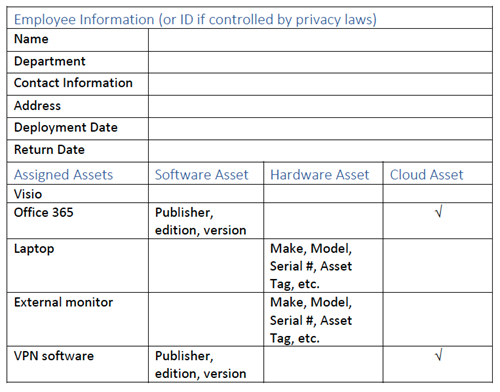Coronavirus: ITAM’s Immediate Response
Here in the U.S., as in many countries, the Coronavirus has forced employees to work from home. This is new to many organizations and they are scrambling to replace desktops with laptops to be sent home with their employees. This creates some extra work for IT asset managers along with challenges to existing IT roadmaps and budgets.
The following is a list of tasks that should be addressed as soon as possible:
Hardware Asset Inventory Management
How are you recording the temporary deployment of hardware assets to employee’s homes? What are you tracking? Only the device? Or do you need to also track keyboards, mice, external monitors, docking stations, industry specific peripherals, etc.? At some point these assets will be returned to you, hopefully when the employee returns to the office. The re-use of these assets may also need to be considered and planned for at this time.
Software License Inventory Management
Almost identical to Hardware Asset Inventory Management above, what licenses were deployed and what licenses can be harvested upon return? Keep in mind software that was purchased and deployed for the sole purpose of supporting the remote work force such as VPN software, collaboration software, and telecommunication software.
Cloud Subscription Inventory Management
Cloud subscriptions can be coupled with software titles so it may require tracking both as connected assets. Some cloud service providers are offering a free subscription for a limited time to companies of certain sizes. These assets must be managed as you would a leased asset with a lease or term schedule. Any additional cloud subscriptions that are acquired for the sole purpose of supporting a remote work force will need to be disposed of at the end of its use.
Software License Usage
The deployment of a second hardware asset for work at home employees may require additional licensing. The general rule of thumb: if the software is installed, it consumes a license. If Mary has application ‘A’ installed on her desktop and is then provided a laptop with application ‘A’, then Mary may be consuming two licenses. This scenario may have an impact at true up time as well.
Likewise, server licensing must also be examined to determine what, if any, impact additional devices may have on license usage.
It is therefore strongly recommended that you review each software title’s licensing agreement. Track not only where and what was installed but also if the software was installed for this emergency situation.
Conclusion
There is an immediate impact on the responsibilities of the IT asset manager. The table below is a summary and simple example of what was presented above. The content can be recorded in a variety of tools including an ITAM repository, a CMDB, and yes, even a spreadsheet. What is important is that the information is captured.

MCPC engineers outcomes. A global endpoint management company, our proactive partnership inspires not just endpoint defense, but business offense. By protecting your devices, bringing simplicity to endpoint management complexity, and empowering employee performance, MCPC reduces business risk and increases digital innovation.
Driven by the kind of trust that transforms today’s business and tomorrow’s growth, our consultative approach creates a true partnership where your endpoints are just the starting point.